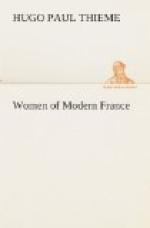The hotel of the famous poet Scarron—Hotel de l’Impecuniosite—received almost all the frequenters of Ninon’s salon. At the former place there were no restrictions as to the manner of enjoyment; after elevating and edifying conversation at the salon of Ninon, the members would repair to that of Scarron for a feast of broutilles rabelaisiennes [Rabelaisian tidbits].
The salon of Mme. de Montbazon had its frequenters who, however, were attracted mainly by her beauty; she was, to use the words of one of her friends, “One of those beauties that delight the eye and provoke a vigorous appetite.” Her salon was one of suitors rather than of intellectuality or harmless sociability.
The most famous of the men’s salons was the Temple, constructed in 1667 by Jacques de Souvre and conducted from 1681 to 1720 by Phillipe de Vendome and his intendant, Abbe de Chaulieu. These reunions, especially under the latter, were veritable midnight convivia; he himself boasted of never having gone to bed one night in thirty years without having been carried there dead drunk, a custom to which he remained “faithful unto death.” His boon companion was La Duchesse de Bouillon. Most of his frequenters were jolly good persons, utterly destitute of the sense of sufficiency in matters of carousing; the better people declined his invitations.
After that of Mme. de Rambouillet, there were, in the seventeenth century, but two great salons that exerted a lasting influence and that were not saturated with the decadent preciosite. Of these the salon of Mlle. de Scudery has been called the salon of the bourgeoisie, because the majority of its frequenters belonged to the third estate, which was rapidly acquiring power and influence.
Mlle. de Scudery, who was born in 1608 and lived through the whole century, saw society develop, and therefore knew it better than did any of her contemporaries. Having lost her parents early in life, her uncle reared her and she received advantages such as fell to the lot of few women of her condition; she was given an excellent education in literature, art, and the languages.
Until the marriage of her brother, she was his constant and devoted companion, exiling herself to Marseilles when he was appointed governor of Notre Dame de La Garde, and returning to Paris with him in 1647. She first collaborated with him in a literary production of about eighty volumes. In their works, the brother furnished the rough draft, the dramatic episodes, adventures, and the Romanesque part, while she added the literary finish through charming character sketches, conversation, sentimental analyses, and letters. With a strong inclination toward society, and constantly fulfilling its obligations, she would from day to day write up her conversations of the evening before.




